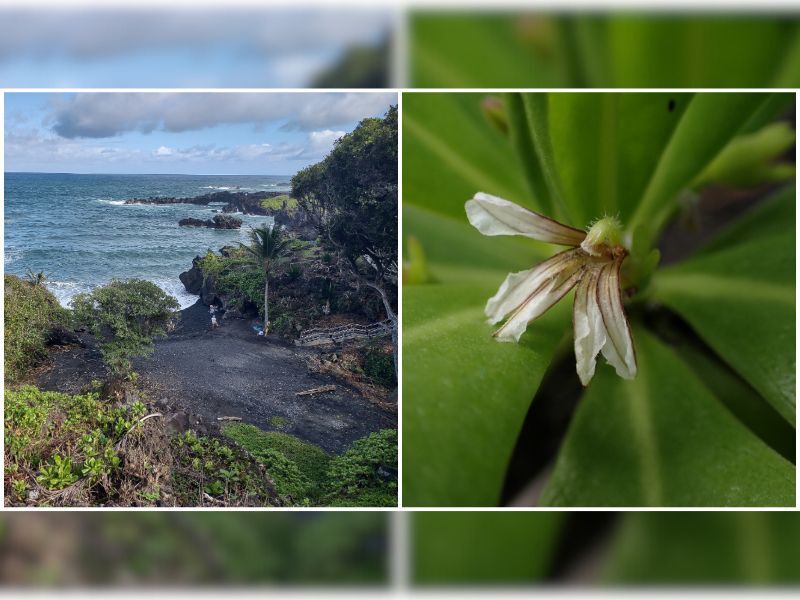Waves crashed onto the black sand beach at Waiʻānapanapa State Park near Hana, Hawaii. This was our final stop on the Road to Hana, and our last big adventure of the trip.
From the high point overlooking a cove, my parents and I focused our binoculars on a cluster of seabirds sitting on a rock draped in some tough plants and white bird poop. Noio are an endemic subspecies of black noddy with pale gray tails and orange legs. While their cousins are global travelers of tropical and subtropical seas, noio arrived in Hawaii on their wings and then stayed.
Feeling adventurous, I descended several flights of stairs to the beach, wiggled my toes in the black sand, and then climbed a craggy cliff of young, black basalt on the far side. When a cluster of ferns caught my eye, I paused to look closer. The smooth fingers of the fronds reminded me of common polypody, a fern that often grows on top of boulders in the Northwoods. In the same family, this golden polypody fern could have arrived through spores blown on the wind, but my sources list it as introduced, so it probably arrived here through human interference.
At the top of the headlands, I stood in awe as waves crashed into the rocks and tossed salty spray high in the air.
Wings, wind, and humans are three of the most common ways that life has arrived on Hawaii since the volcanoes rose above the ocean. But besides the obvious humpback on a whale watch, I hadn’t noticed many who had arrived on the waves. As I descended the trail back to the black sand beach, a tiny white flower caught my eye. Recognizing it as Beach Naupaka, or Naupaka kahakai from my nature guide Wind, Wings, and Waves by Rick Sohren, I stopped to take photos.
Five white petals, each about 2 cm long, were lined with lovely wine-colored accents. The shape was what gave it away – the petals all drooped down, giving the appearance that this was only the lower half of the flower. There are many different folktales about Naupaka, which represent at least 9 species who grow both on the mountains and shorelines, and they all read a little bit like Romeo and Juliet, with star crossed lovers who will never be reunited until the flowers are made whole.
After checking out the succulent, oval, green leaves that surrounded the flowers, I suddenly realized that Naupaka was growing everywhere on the rocky cliffs! The low shrubs lazed about and crept over rocks on pale gray branches. Naupaka kahakai are great for shoreline stabilization, and may be the most widely used native plant in Hawaiian landscaping. Unfortunately, their robustness also makes them invasive in Florida, where they aren’t native.
I spotted a couple of white berries among the leaves. These berries are sometimes called Huahekili, which means "hailstones" in Hawaiian. While the Naupaka berries were famine food, they are said to be bitter and slimy. Inside the slimy berry flesh is where the real magic happens.
Naupaka kahakai seeds can float in seawater for more than a year and still manage to germinate once they land. Once ashore, they are very tolerant of salt spray, although not of being inundated daily. Lucky for them, Hawaii is so far out in the open ocean that it experiences relatively small tides.
Not only can Naupaka kahakai seeds survive seawater, they seem to need it for germination. One native plant guide suggested that soaking them in salt water made it easier to grow them from seed.
These durable – but picky – seeds reminded me of several others back home. The next generation of jack pine trees are squirreled away in sealed cones until fire softens the pitch and releases seeds onto freshly cooled ash. Raspberry seeds sprout best if their hard coats have been softened by stomach acids of a hungry bird or bear. Tiny, poppy-seed-sized columbine seeds can only germinate in the presence of light. Violet seeds prefer dark. And many of our native plants, including common milkweed, must experience several months of cool, damp “winter” conditions whether outside or in your refrigerator.
Likewise, the seeds of my excitement about Hawaii didn’t germinate quickly. I flew there (arriving on wings!) planning to check off my 50th state and visit a bunch of places I’d organized on a spreadsheet. Once there, I found myself exposed to impressive ocean vistas, soaking up the sun and tropical humidity, being fertilized with cool facts at every park, and being drawn out of my shell by the light of curiosity. After seven days in Hawaii, and two months writing about it, my appreciation for the state sprouted like a weed and is ready for another trip!
Emily’s award-winning second book, Natural Connections: Dreaming of an Elfin Skimmer, is available to purchase at www.cablemuseum.org/books and at your local independent bookstore, too.
For more than 50 years, the Cable Natural History Museum has served to connect you to the Northwoods. Our exhibit: “The Northwoods ROCKS!” is open through mid-March. Our Winter/Spring Calendar of Events is ready for registration! Follow us on Facebook, Instagram, YouTube, and cablemuseum.org to see what we are up to.
Last Update: Jan 31, 2024 8:39 am CST
















